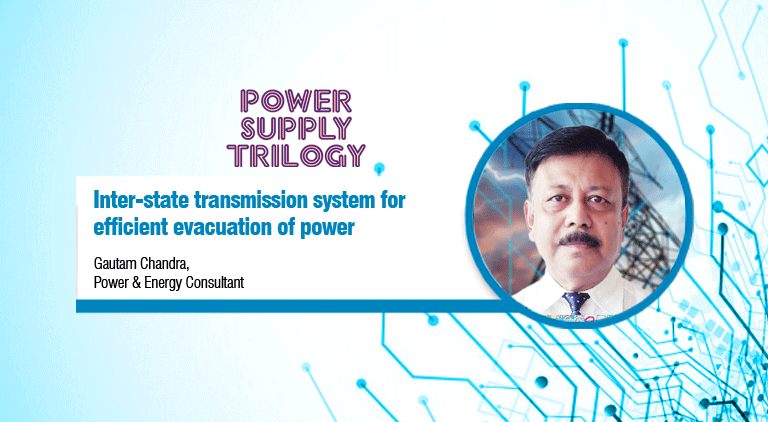Inter-state transmission system for efficient evacuation of power
By EPR Magazine Editorial November 18, 2019 12:10 pm IST
By EPR Magazine Editorial November 18, 2019 12:10 pm IST

To stand tall against the growing menace of cyber attacks, we need to gain experience from major developed nations who are thriving against this menace with means to negate the threats.
Gautam Chandra, Power & Energy Consultant, in an interaction with Athira Bejoy discusses what could have been done and what can be done to holistically plan the generation and equal distribution of power.
Holistically planning generation and distribution
I think yes, it is a long awaited and welcome move! In fact, growth of power sector has been impaired due to lack of holistic planning from the very beginning. 50 years ago we were at a very primary stage of development in power sector. India improved its generation capacity after NTPC was formed in November 1975, witnessing accelerated growth of power generation. After few years, we realised that five of our regional grids were unstable due to disparity in demand and supply, and insufficient transmission lines to connect the inter-regional grids. PGCIL executed many high capacity transmission lines and gradually connected our regional grids with strong links. We started connecting our regional grids in 1991 and finally on 31st December, 2013, we have connected all grids in synchronous mode to have a common strong and stabilised national grid.
While our country was galloping with increased generation capacity and strong transmission network, it was again realised that there are constraints in power supply. This to the end users in the form of poor distribution network, unevenness in coal production and the generation capacity, scarcity of railway wagons to supply coal, poor financial condition of the DISCOMs who are the purchasers of all power, among many others.
In a nutshell, our country should have planned holistically to address issues like generation, transmission, distribution, coal availability and finances. Therefore, moving away from power generation and focusing on supply is essential as this can successfully achieve a much stronger industrial and commercial growth in the stage.
Reforms for AT&C loss reduction and making DISCOMs financially viable
Outstanding amount of DISCOMs to GENCOs had been rising continuously due to non-payment of the billed amount in time and stands at about 78000 crore now. In true sense, we will not be shifting our focus from generation to supply, as the country still have the target of adding 175 GW of renewable energy by 2022. We will be just doing away with fossil fuelled generation. Also, our focus on supply started long back when Electricity Act 2003 was framed which paved way for open access and private participation in distribution and power trading.
Series of reforms measures were taken to make the DISCOMs financially viable entities through operational and financial reforms schemes. However, against the indented objectives, very less could be achieved. Target of AT&C loss reduction to 15 per cent by 2019 and elimination of gap between ACS and ARR are nowhere near achievement level. Private participation in distribution was successful only in Delhi and franchisee scheme in a few other circles. Progress in 100 per cent metering, automated billing system and IT enabled energy accounting has been meager and had been successful to some extent in urban areas only.
UDAY 2.0, supposedly aimed at filling the gap areas of UDAY 1.0Infrastructure for evacuation of power
India is presently passing through a phase of massive addition of renewable power, most of which are grid connected. Plethora of mega solar projects announced including inter-state connected transmission system (ISTS) projects, where evacuation of power is a big challenge. Moreover, the seven renewable rich states in west and south don’t absorb this power and therefore have to be evacuated to power deficit states. Therefore, massive investment is required to build a renewable grid connecting these states and corresponding inter-state transmission system for proper evacuation of such power.
In fact, mechanism for evacuation of such additional huge renewable power growth should precede the growth of generation because gestation period of such transmission lines are more than that of installing renewable energy plants. Growth of solar generation has already slowed down due to non-availability of power evacuation lines at many places. It is heartening to note that government has already started work on green corridors for connecting the renewable energy sources and also allowed private participation in building transmission network to accelerate the growth of required transmission infrastructure. It is required to debate and plan for dealing with the changed dynamics of the grid with two way power flow in near future when more and more number of grid connected solar rooftops are put in place.
Cyber security: Taking cues from the developed nations
Growing digitalisation and net connectivity of our distribution network has made it vulnerable to cyber attacks. A successful cyber attack can result in partial or complete grid failure paralysing the nation and is a great security threat to the country. Hackers are becoming more sophisticated day by day and a strong and highly professional anti hacking team are required to match or outsmart the hackers. In India, today, CERT-in looks after cyber security and it circulates advisory after cyber attacks. Our country have not yet risen to the occasion to fight this huge security threat in form of framing new legislatures, adopt proper technology and preparing and implementing standard practices and procedures on this subject . To stand tall against the growing menace of cyber attacks, our government need to gain experience from major developed nations like U.S, U.K and Australia who had been thriving against this menace since quite some time and have developed ways and means to negate the threats to a large extent.=
Gautam Chandra,Power & Energy Consultant
We use cookies to personalize your experience. By continuing to visit this website you agree to our Terms & Conditions, Privacy Policy and Cookie Policy.